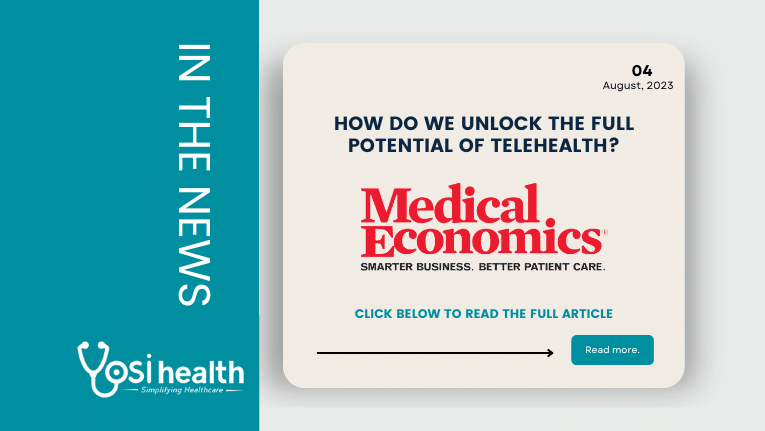
How do we unlock the full potential of telehealth?
The healthcare industry is witnessing a remarkable transformation in the way medical care is delivered. Telehealth, a concept once considered futuristic, has now become an integral part of the healthcare landscape, in large part due to its wide use and adoption during the pandemic.
Despite its revolutionizing impact on patient access and streamlining practice operations, telehealth remains underused in primary care.In fact, according to a 2021 HealthIT.gov study, over half of office-based physicians provided care via telemedicine for fewer than 25% of patient visits, and less than 20% of physicians used telemedicine for more than 50% of patient visits.
That lack of adoption means many outpatient primary care doctors are missing out on the demonstrated benefits of telehealth, such as reducing the need for in-office visits, easing the burden on the administrative staff, and providing unrivalled convenience for patients.
Several factors contribute to this underutilization:
Resistance to change: Many healthcare practitioners are accustomed to the traditional in-person consultation model and may be hesitant to adopt new technologies.
Regulatory challenges: Varying state regulations and insurance reimbursement policies have posed hurdles for healthcare providers seeking to implement telehealth services. The evolving regulatory landscape has created uncertainty and slowed adoption.
Technological barriers: While telehealth technology is more accessible than ever, some practices may lack the necessary infrastructure or expertise to integrate these solutions seamlessly into their workflows.
Patient reluctance: Some patients, especially older adults, may struggle with or be reluctant to use technology for their medical appointments. This has led to concerns about patient engagement and satisfaction in telehealth encounters.
For outpatient primary care doctors, embracing remote engagement technology offers an array of benefits that go beyond the immediate necessity of virtual visits. These benefits reshape the way practices operate and improve patient care:
Reduced in-office visits: Telehealth technology allows physicians to conduct routine check-ins, follow-ups, and consultations virtually, reducing the need for patients to visit the clinic for non-critical issues. This not only saves patients time but also frees up valuable clinic slots for more critical cases.
Streamlined workflow: By incorporating telehealth into their practice, doctors can optimize their schedule, reducing wait times for patients during in-person visits. This efficiency benefits both patients and staff, enhancing overall practice productivity and patient satisfaction.
Enhanced patient engagement: Telehealth offers patients a more flexible means of accessing medical care, leading to increased engagement. Patients are more likely to seek medical advice promptly when it’s easily accessible, leading to better management of chronic conditions and improved health outcomes.
Remote monitoring and chronic disease management: Telehealth enables continuous remote monitoring of patients with chronic conditions. This real-time data collection allows doctors to make informed decisions about treatment adjustments, reducing the need for frequent in-person visits.
Integrated care: Telehealth solutions can facilitate interdisciplinary collaboration among healthcare providers, enhancing care coordination. Primary care doctors can more easily consult with specialists, share patient information, and collectively make informed decisions.
Patient convenience: The convenience of telehealth appointments cannot be overstated. Patients can consult with their doctors from the comfort of their homes, eliminating travel time, waiting room discomfort, and associated stress. These patients report positive experiences on evaluation surveys.
Reduced burden on office staff: Doctors rely so much on their administrative support teams that losing any member impacts a practice’s productivity. Because telehealth significantly reduces the administrative burden associated with managing in-person appointments, office staff can stay focused on other critical tasks and experience less stress because of it.
As healthcare delivery continues to evolve, medical practices are well advised to embrace contemporary consumer behavior. Telehealth technology is an untapped gold mine for primary care doctors, offering enhanced patient care, streamlined operations, and reshaping the doctor-patient relationship.
While challenges such as regulatory complexities and technological barriers persist, the benefits far outweigh the hurdles. By embracing telehealth technology and leveraging its value, outpatient primary care doctors can truly revolutionize their care workflows, supporting their desire to deliver patient-centered, efficient, and accessible health care.
But incorporating telehealth is more than just an adaptation to the changing times; it’s an opportunity to thrive in a dynamic consumer-centric healthcare landscape. As the industry continues to witness the transformational power of technology, telehealth is a beacon of innovation, bridging the gap between patients and healthcare providers while ensuring the highest standards of medical care.
Hari Prasad is the co-founder and CEO of Yosi Health.
For more details, Click Here
